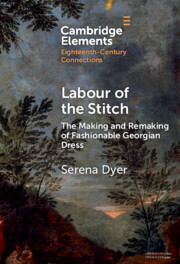Labour of the Stitch
The Making and Remaking of Fashionable Georgian Dress
Published online by Cambridge University Press:
27 March 2024
- Serena Dyer
- Affiliation:
De Montfort University
Summary
The making of fashionable women's dress in Georgian England necessitated an inordinate amount of manual labour. From the mantuamakers and seamstresses who wrought lengths of silk and linen into garments, to the artists and engravers who disseminated and immortalised the resulting outfits in print and on paper, Georgian garments were the products of many busy hands. This Element centres the sartorial hand as a point of connection across the trades which generated fashionable dress in the eighteenth century. Crucially, it engages with recreation methodologies to explore how the agency and skill of the stitching hand can inform understandings of craft, industry, gender, and labour in the eighteenth century. The labour of stitching, along with printmaking, drawing, and painting, composed a comprehensive culture of making and manual labour which, together, constructed eighteenth-century cultures of fashionable dress.

